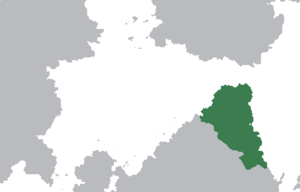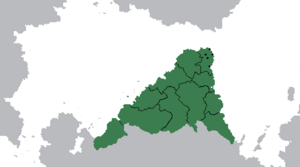Doccábh people
| This article is part of a series on |
| Doccábh culture |
|---|
 |
| Pre-imperial history |
| Imperial history |
| Modern history |
| Related topics |
The Doccábh (Classical Doccábh /do.ˈka:β/) were an ethnolinguistic and cultural group located in northern Yazland identified by their use of the Doccábhan languages, a branch of the Yasgan language family.
Prehistorical and Archaic periods

The Doccábh peoples were originally part of the greater Proto-Yasgan cultural group, sharing linguistic and cultural similarities primarily with the Gintem and North Yasgan groups, residing to the west of the land traditionally considered Doccábhan, later migrating into the land inhabited by the North Yasgan peoples and displacing them around 800CY. They were still largely hunters, although had domesticated animals, and skilled metalworkers. Their agriculture revolved largely around sorghum, wheat, and the bean. Their culture was more distinguishable from the other groups in the area by the year 1200CY (see image to the right). They began becoming more sedentary, as the agricultural practices evolved to allow for surpluses, with urbanisation beginning into the 1600s CY.
Aristocratic period
During the Aristocratic period, the land occupied by the Doccábhan tribes was ruled by many disparate kingdoms and city-states. Despite this, cultural unity was largely the case, though regional variation existed. Many of the smaller states were effectively ruled by nearby larger states.
Near the end of the Aristocratic period, one particularly large state, the Fúigimic kingdom, had come to control of a significant portion of the eastern land. A drought or something possibly along with the Khozathians made it so that they could just kinda sweep? Shit was bad after too it just like was under one monarchy trying to keep control of all the land (very good idea)
Regal period

After the instability of the Aristocratic period, something something Fúigimic kingdom rules them all for like 500 years lmfao. This kingdom was, similarly, relatively unstable and fraught with civil war, especially towards the end of the kingdom's lifespan.
The regal period was marked by an increasing inclination towards more democratic reform. During this time period, however, the monarchy refused to give up the system of dynastic succession at any point, despite public outcry frequently being specifically about the powers the king held.
Rulers of the Regal period
Rulers were frequently referred to with the title áirreann, literally meaning "forever-king".
| Birth | Reign | Name | Notable information |
|---|---|---|---|
| c. 1894CY | c. 1924CY-1969CY | Fúigimi | Considered the founder of the Doccábhan state. |
| c. 1944CY | c. 1970CY-2003CY | Feicteág | Son of Fúigimi. |
| c. 1972CY | c. 2003CY-2025CY | Gaideannoc |
Rule of the Quinquevirate


After the something, calls for democratic reform, end to monarchic rule, and relatively municipalist governance grew louder. In the end, five aristocratic families came forward to establish one of the first republics in the world.
how did the government work
i think there would be a system of 5 ""monarchs"" at the top, and a separate parliament, almost like a parliamentary democracy? this would come about after a long period of "damn having only one ruler fucking sucks" of the regal period. the parliament would be made up of various nobles; maybe eventually they would have a house of commons
what was their relation to other places? (dhimrai usw)
probably depends over time
what if they went up north...
that would be fucking crazy and fall apart. they should do it
Fall of the Quinquevirate
🦀the gay celts are dead🦀
The fall of the Quinquevirate, and by extension the Doccábh Empire, can be attributed to a combination of factors culminating in the final years of the empire during the 30th century CY. Primary among these is the displacement of the Gintem peoples from their native lands by the Milevic expansion during this time period. Anti-Gintem sentiment already existed among the empire, with the Gintem peoples largely being considered uncivilized barbarians, pushing the Gintem to mount a hostile invasion of the eastern portion of the empire. Due to military funds already being spread thin across the imperial frontier, novel military strategies from the Gintem, and internal corruption, the east quickly collapsed, causing a major loss in soldiers, morale, and farmland. The west, now starved and under attack by outside forces themselves, revolted, further draining funds from the imperial core. By the year 3350CY, the empire had essentially become defunct.
Legacy
The Doccábhan Empire has a significant and varied legacy across the world, especially on the modern cultures found in Yazland, Etzavaz, and southern Ashnan. It had a long-lasting influence with large geographical reach and affected governance structures, law, cultural beliefs, technological advances, and language, and the effects of its presence can be deeply felt today.
Law
The Something legal system created the principles on which the law of many modern countries is based. Much legal terminology across the countries most influenced by the Doccábhan Empire comes directly from Classical Doccábh, and the general structure of jurisprudence is the same as used in the imperial period.
Modern democracy was pioneered by the system used during the Quinquevirate.
Language
loan words
Writing system
they did that too
other shit probably